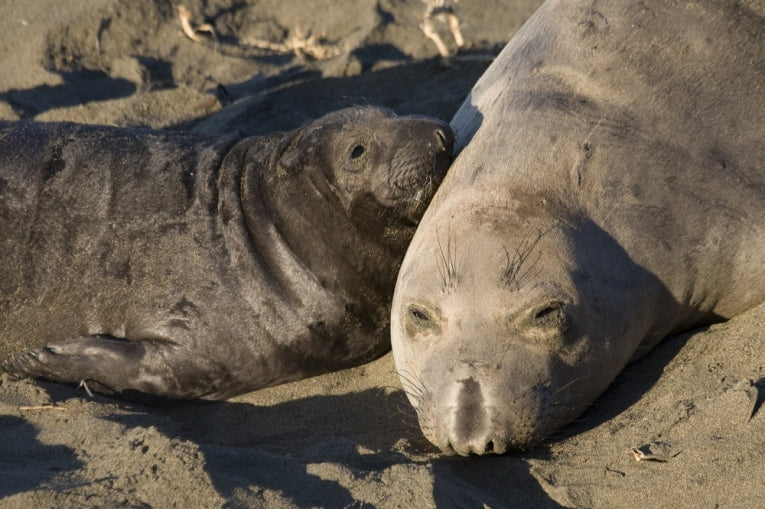The northern elephant seals migrate throughout the north-east Pacific. They are foraging there on populations of squid and fish at an interface or gyre between the two rotating oceanic currents in sub-polar and sub-tropical regions. 297 individuals were tagged and tracked from 2004 to 2010 by the University of California, San Diego and Santa Cruz, with lots of input from Sonoma State University, Centro de Investigacià ³n en Alimentacià ³n y Desarrollo A.C., Unidad Guaymas, Mexico, Alaska Fisheries Science Lab., NOAA. in Seattle, US, the Marine Mammal Commission in Maryland, US., and Nagoya University, Japan.
Concentrations of prey along the gyres are presumed to base themselves on a phytoplankton food web that relies on the nutrients from the cold current and the warmth of the sub-tropical temperatures. Twice a year, females voyage for two months after weaning their young, and then leave the rookery again for a post-moult migration that lasts eight months. The foraging trips need to be successful for the pup size to be increased with rich milk.
All seals need to develop fat reserves for their lifestyle, but elephant seals are the ultimate in mass and diving ability. Their foraging strategies are diverse too, because many do not simply follow the herd. They stay behind in coastal waters and exploit the continental shelf, just like the large female who made the deepest dive surveyed near Vancouver Island. She made it straight down to 1754m or 5788ft. Such differential behaviour could be of tremendous importance as climate change literally demolishes established fishing patterns in the Pacific.

Credit: PLoS ONE / doi:10.1371/journal.pone.0036728.g003
(Above image) Approximate location of dominant oceanographic features in the northeast Pacific Ocean. The stippled region indicates the annual range of the Transition Zone Chlorophyll Front (TZCF). The location of the gyre-gyre boundary remains stable in contrast to the annual migration of the TZCF.
As well as the seals, shark, tuna and albatross and many others use this food web, but these super-seals dive really deep to follow the gyre where it is invisible to surface or satellite surveillance. This study by 19 researchers published in PloS ONE used one of the largest mesopelagic datasets to explore this type of foraging behaviour and variability over the annual cycle.
Patrick W. Robinson et al include undergraduates and professors who have spared many years of their lives to achieve a continuous record of the species' ecology. What they have achieved is a set of 184 complete datasets showing horizontal, vertical and dive activities along with morphometric and mass measurements.
The group managed to record temperatures in the Pacific at great depths (see below) which itself illustrates how useful this data is to marine science. Perhaps wise and just as well they didn't try that on those gigantic males!

Tagged female elephant seal prepares to dive; Credit: Dan Costa

Credit: PLoS ONE / doi:10.1371/journal.pone.0036728.g007
(Above graph) Temperature profile and female northern elephant seal density along a transect of the ~163W meridian from 40N to 50N. The temperature profile was created from TDR (time depth recorder) data between 28-July-2005 and 24-August-2005. The 8°C isotherm, indicated with a black line, highlights the temperature inversion. The seal density was extracted from the inter-annual August density. The grey bar shows the position of the gyre-gyre boundary.
The elephant seal is probably the most studied marine mammal, but with decades of information within this data, it now provides information that is extremely useful for organisms such as those elusive and far-ranging predators that are almost impossible to follow. The whole ecosystem opens up, including huge varieties of predators and their prey.
Hopefully, the almost unknown foraging patterns of sperm whale, beaked whale, blue shark and salmon shark can now be investigated using the seal data as a window into conditions from the Arctic to sub-equatorial waters.










